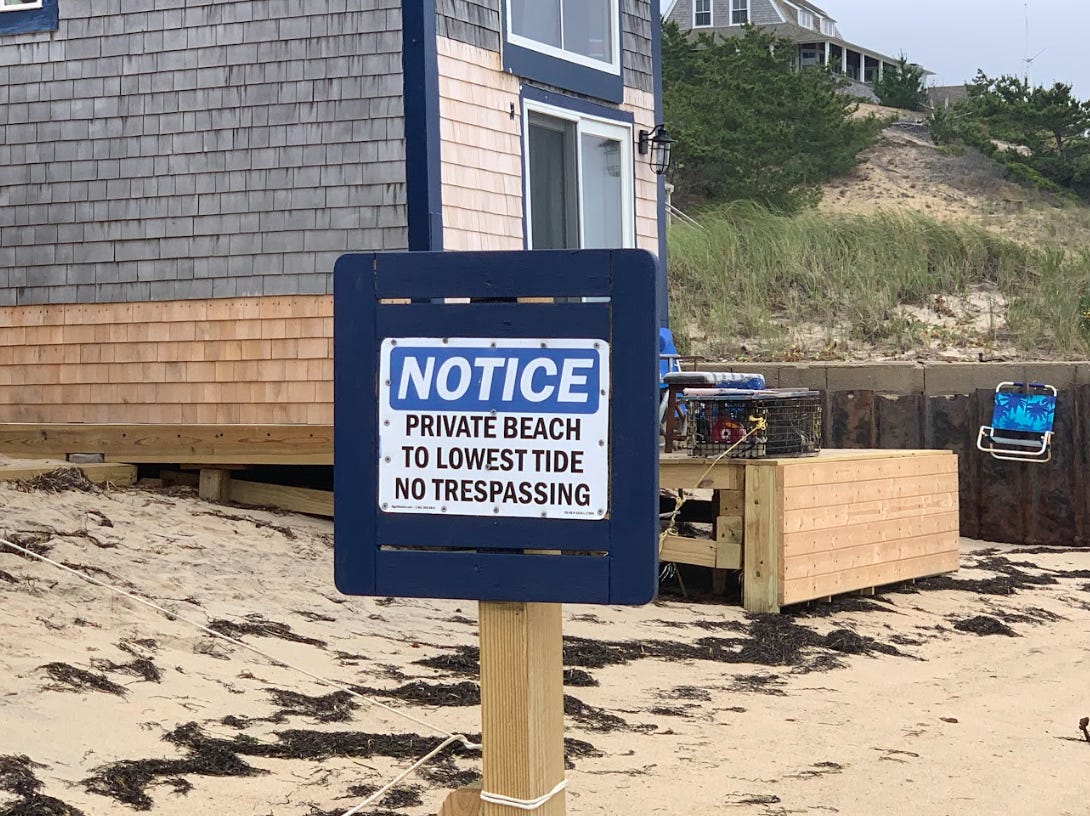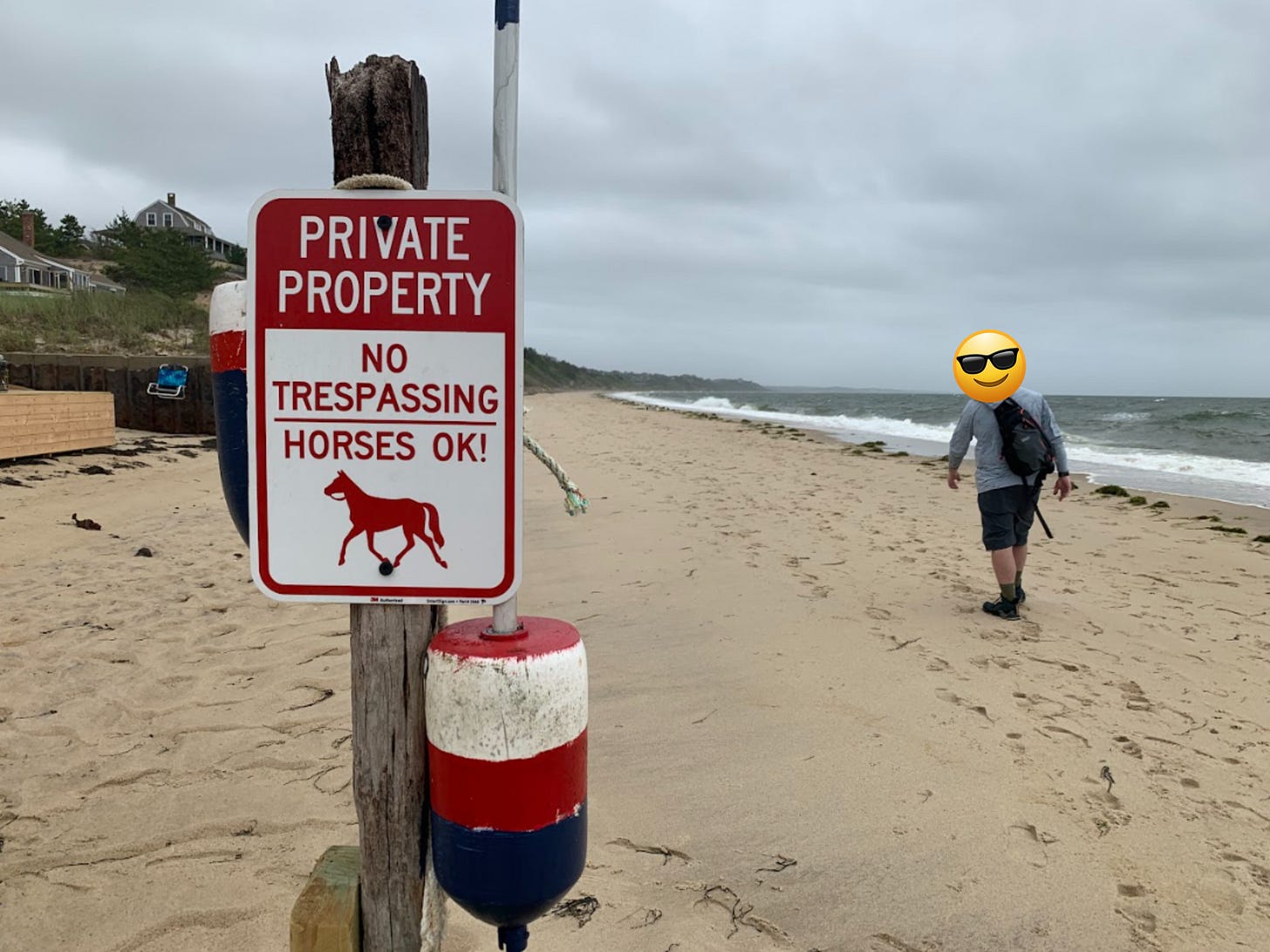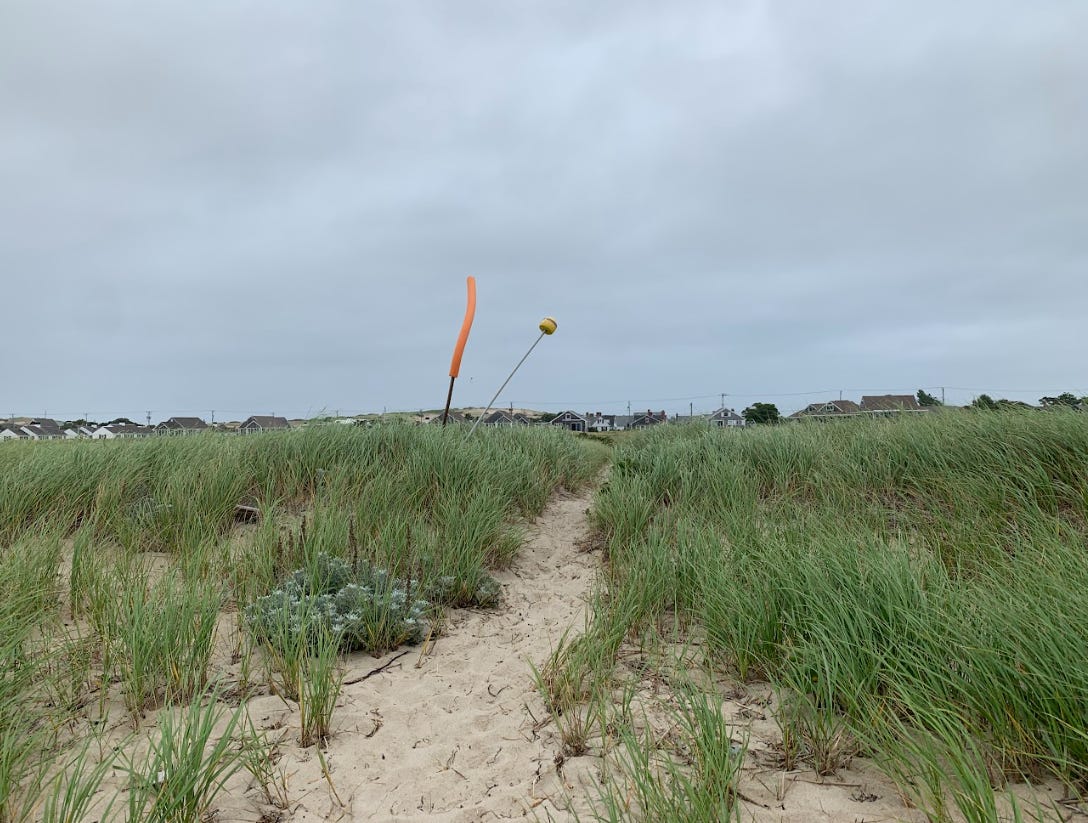Rustling dune grasses. Chattering gulls. The foamy, softly roaring maw of the Atlantic Ocean. The coast of Massachusetts might be the state’s most iconic feature—a place of wonder, where you might encounter anything from a violet dusk worthy of Winslow Homer, to a whale carcass breaking down under the sun. But I want you to take a stab at guessing the percentage of the Massachusetts coastline that’s open to the public.
An optimistic 80%?
A more cynical 30%?
Something in the middle?
If you wagered any guess within that spectrum, I hate to tell you that it’s time to grind that number down….by a lot. The most recent state survey of Mass. coastal access was done about 30 years ago, and it found that only 12% of Massachusetts’ coast is publicly accessible. The other 88% of our shoreline is either privately owned outright, or only accessible by people who happen to own private property along the coast.
Let me explain how this works. In most states, it’s legal to own coastal property down to the high tide watermark. The intertidal zone between the high tide line and the low tide line is usually considered No Man’s Land. But Massachusetts is one of a small handful of states where you can own the beach all the way to the low tide watermark. If you own a beach house on the North Shore that’s near a crowded public beach, and a couple of beachgoers wander beyond the confines of that beach onto your beach, by rambling through the intertidal zone—which, again, is legal in most of the U.S.—then you have the right to tell them to buzz off, and to call the cops if they refuse to leave.
What this means, in practice, is that a lot of Massachusetts residents and visitors will never set foot on the sands during the height of summer. The small handful of public beaches that don’t come with subtler restrictions like Resident Only parking rules are reliably packed. And some of them, such as Crane Beach, carry hefty admission fees for vehicles. But my intention here is not shitting on The Trustees, which manages the Crane Beach grounds and imposes fees. The level of activity concentrated upon Crane Beach and others like it requires a ton of management resources, and all of this is the logical conclusion of Massachusetts’ beach ownership policy. The majority of us are forced to share a pithy slice of the shoreline, while a lucky few get to bask in the rest of it. So you might wonder; What would happen if I knowingly crashed a private beach?
The short answer to that question is, a lot could happen. Your beach trespassing foray might go swimmingly! Or a coastal home owner might spot you, confront you, and tell you to leave. They might ask politely, or they might scream at you until they’re purple in the face, which happens more than you’d think or hope. You might be able to settle the matter by walking away. Or you may find yourself having to feign ignorance, if the home owner calls the cops and they actually show up. “I didn’t know that the intertidal zone if off-limits too,” you can say. They might buy it. Or they might give you a citation.
Given these potential outcomes, why trespass on a privately owned beach in Mass.?
Last year, I teamed up with adventure photographer Dan Brown and I penned an 8,000-word story about beach trespassing for the 203rd issue of Mountain Gazette (which you can still get your mitts on by clicking here.) The thing that inspired Dan and I to go for a legally dodgy beach walk from Provincetown to Truro—following the footsteps of Thoreau—was the realization that even if the Massachusetts legislature chose to open up the intertidal zone to the public, enjoying our newfound right to walk in that zone is probably still going to feel like trespassing. For the early years, at least. When Rhode Island opened up more of its coast to the public, it didn’t take long for local media to circulate a rather wild story of a beachgoer who was assaulted by an adjacent home owner. The latter had spotted the former and ordered them to leave. And when the beachgoer stood their ground and correctly asserted their legal right to be on the beach, the homeowner snapped their beach umbrella and chucked it into the surf.
The cops were summoned and thankfully the beachgoer was not improperly cited or arrested. And that, of course, is the difference between what can happen if you walk the intertidal zone in Massachusetts at this time, and what might happen if that zone becomes public domain in the future. Nonetheless, there’s a potential social benefit that comes with a trespass walk; for the trespasser and even the landowner. And that is having a reasonable discourse about your presence on the beach. That’s something the state cannot facilitate. Learning how to co-exist with each other on the coast is a task that will be left up to us, even if the intertidal zone is given back to the public. The journey that Dan and I took down the inner Cape last summer was a useful exercise in having conversations with fellow beachgoers and home owners, in which neither of us assumed the worst of each other. That’s not to say that every exchange went down harmoniously (and sometimes one bad exchange is all it takes to end a trespassing walk) but we returned home from our walk mildly sunburnt, moderately dehydrated, and cautiously hopeful about whether Mass. residents can grow to share the sands.
We also saw a colorful range of beautiful and strange things along the beaches that connect Provincetown and Truro. Cumulonimbus clouds! Seaglass art! A mystifying amount of dead bees in the sand! Enough seaweed to choke a Mosasaurus! Walking through territory where walking is possible but not technically allowed is a classical genre of adventure. And if you’ve made it this far and still haven’t thought, “Nope, not for me,” I’m going to share some field tested advice—in the event that you want to hit Cape Cod and follow in the footsteps of not just Thoreau, but Dan and myself as well.
Recruit your accomplice(s) thoughtfully
As much as some of us enjoy a good solo walk in a wild place, traversing the beaches from P-Town to Truro is a riskier undertaking that’s best done with a small unit. And the task of recruiting your accomplice(s) requires consideration beyond, “Who’s up for getting extremely pruny feet from having to walk in the tidewaters for a few hours?”
If you have a hiking buddy who’s prone to getting testy when confronted by other folks, this is not the adventure to invite them on. The same goes for any friends who might feel the string of a trespassing citation extra hard—such as a friend who was arrested or fined for something else within the last year or two. Exposure to the teeth of the law is going to be different for each of us and unfortunately, that’s a really important thing to mull over when considering a foot journey along most of the Massachusetts coast.
So what should you look for, in an adventure buddy for this particular adventure? An appetite for sun, sand, and surf, of course. But also a knack for de-ecalating situations that might get tense. Courage. And openness to changing plans on rather short notice.
Know your entrance, exit, and at least one escape hatch
Dan and I began our beach walk at Provincetown’s Commercial Street beach—one of the town’s publicly accessible beaches. For our destination, we chose Corn Hill Beach; a more seluded beach in Truro, roughly 8 miles from Commercial Street beach by foot. We staged one of our cars at Corn Hill earlier in the day. (We had to buy a beach day pass for this.) Then we took the other car back to P-Town, left it there, completed our walk in about 6-7 hours, and drove the staged car back to Provincetown to pick up the other vehicle. This is one way you might approach planning a Cape Cod beach voyage.
Or you could pick alternative origins and destinations. Fancy a shorter walk? Consider ending your journey at Cold Storage Beach instead of Corn Hill. Again, you will need to buy a pass to leave a car there. But it will shave a few miles off the journey, which can be a blessing when your quads and calves are tiring of walking across shifting sands.
But there’s an equally important thing to know, before setting off on a beach walk in Cape Cod. What’s your escape hatch? Let’s say you run afoul of an angry home owner and have to get out of dodge. Or you’re feeling parched and woozy from the sun. You will want to identify at least one place along the route where you could bail early. You’ll pass a lot of paths and staircases connecting the beach to the mainland, but most of these will be privately owned. So the escape hatch should be a public beach or way. If Corn Hill Beach is your destination, Cold Storage Beach is a solid escape hatch. It may mean having to summon an Uber or walk along the shoulder of a road to make it your closest staged vehicle. But such is the nature of walking where walkers aren’t wanted.
Consider leaning into the loopholes
While there’s not that much daylight between the letter of Massachusetts’ beach laws and the art of walking the forbidden coast, there IS one loophole that you might find useful. You see, being able to own the intertidal zone is a law with colonial-era origins. And when our regional ancestors crafted this law, they were at least resonable enough to include a couple of carve-outs—for common activities that can happen in a private intertidal zone. The exceptional activities are fishing, waterfowl hunting, and boating.
The inclusion of boating (toward high tide) and the exclusion of walking is especially frustrating, as this basically criminalizes your feet making contact with the sand in any way. But still, let’s think about those other two activities. Fishing, and hunting for water birds. Carrying shotguns on your beach walk is surefire way to make flashing squad car lights appear in the distance. But carrying fishing rods is another matter.
If you want a little extra padding, legally speaking, you might bring a fishing rod with you on your walk. You don’t actually have to use it. The rod is just a prop that you can point to, in the event that somebody takes issue with your presence in the intertidal zone. And just to make it convincing, you should probably bring a small tackle box as well. Having the rod won’t guarantee being left in peace, but who knows? It may help!
Mind the tides
Maybe this goes without saying, but before embarking upon your beach adventure, it’s really important to know the tidal sequence for that day, by taking a look at a forecast. To leave plenty of time for your walk and lower your odds of having to wade through knee-deep surf—or having to take your chances on a private stairway to higher ground—you will want to set off midway between high tide and low tide, for a 9-hour window.
Be cool
Tempting or intuitive as it might feel to begin your beach trespassing adventure with a righteous chip on your shoulder, you’re going to want to resist the urge to antagonize the local homeowners. Go in hoping for the best and be ready to be conversant and humble. If someone asks you what you’re doing, try saying, “Oh, I’m just out for walk,” and try to avoid adding a scowly, Clint Eastwood-esque “You got a problem with that?”
At the same time, be prepared to bail or pivot if you do run into truly nasty characters. If that happens, try your best to keep your cool; focus on de-escalating by getting out of the area and nothing else. If your beach walk does end this way, let yourself feel all of the feelings that accompany exclusion and unreasonable aggression. The beach laws in Massachusetts are fucked up. The fact that the state still hasn’t updated them for the 21st Century, with our summers getting hotter and muggier, is outrageous. If nothing else, remind yourself that acts of protest—which a beach trespass is—have a way of accruing when there’s a lot of distance between civilians and elected leaders.
You’re not the only person to try walking through the intertidal zone, and you won’t be the last. But hearing about your walk (or witnessing it!) might cause someone else to care about beach access. And in this time of chaos, that’s localized a victory in itself.
If you dug this week’s Mind The Moss story, I *highly* recommend checking out the work of Chris Burrell, the GBH journalist who has been The Guy covering the beach laws in Massachusetts. I learned so much from his stories; they opened my eyes to the absurdity of this land ownership policy and the growing tide of public opposition.
”State law and town rules keep most of the Mass. shoreline off-limits.” Chris Burrell, GBH
”Historic racism still raises barriers to beach access.” Chris Burrell, GBH
”Mass. residents are clamoring for more beaches. The state says it’s listening.” Chris Burrell, GBH
You also might enjoy this feature that I wrote The Boston Globe’s Ideas section a few years ago. While this week’s story was focused on the privatization of the intertidal zone, the sneaky rules that towns employ to block access to beaches that are legally public (such as Residents Only parking rules) are a problem too. And one innovation that could solve this problem would be having transit authorities run seasonal buses to the beaches where the public is allowed to splash and tan. I’d ride one! Would you?
Finally, the “Locals Rule, Tourists Drool” exclusionary energy that lingers over beaches is not just a Massachusetts problem. Surfers run into this too. That amazing scene in Point Break when Keanu Reeves and Patrick Swayze get into a fist fight with a gang of psycho surfers that includes Anthony Kiedis? It’s instigated by Keanu having the nerve to surf at one of these fiercely-guarded beaches. That’s just one iconic scene, but the recent Nicolas Cage film The Surfer builds an entire thriller out of this scenario; not a waterside fist fight, but the shock and humiliation of being kicked off of the beach by local asshole surfers. I saw it a couple of weeks ago and I enjoyed the hell out of it.











In Britain rambling clubs organized mass trespasses to assert the right to access historic paths through private property. Maybe it's time to try that here. See chapter 10 in Rebecca Solnit's "Wanderlust".
12% !?!?! I wonder how Long Island compares.